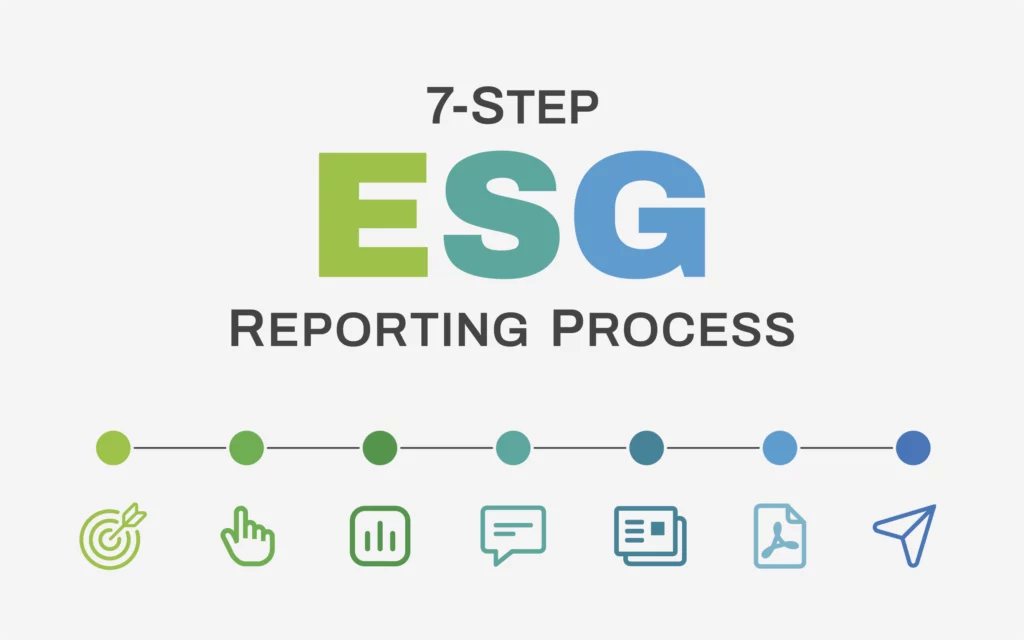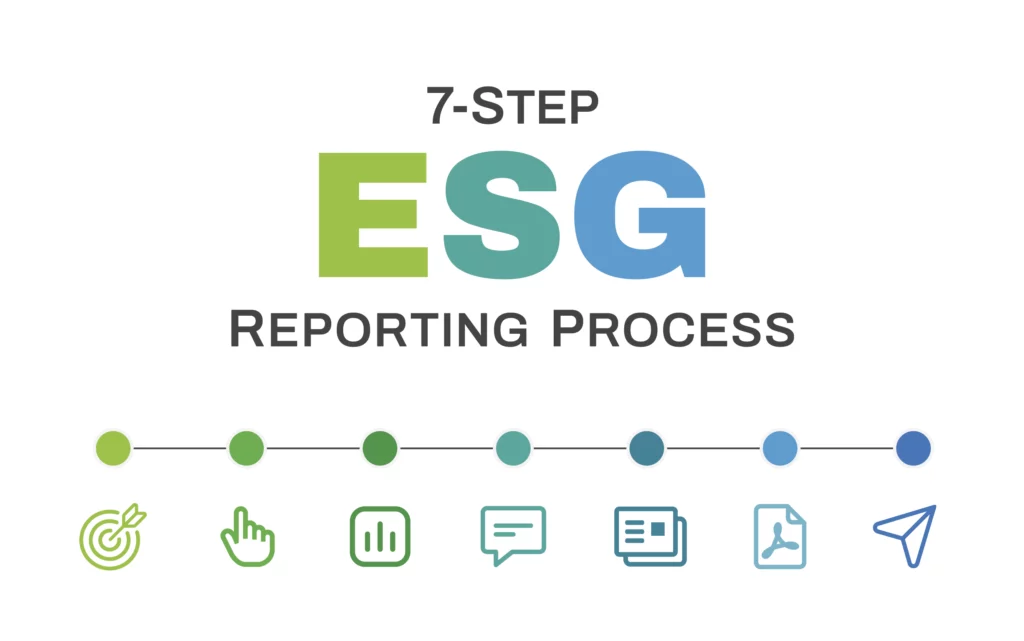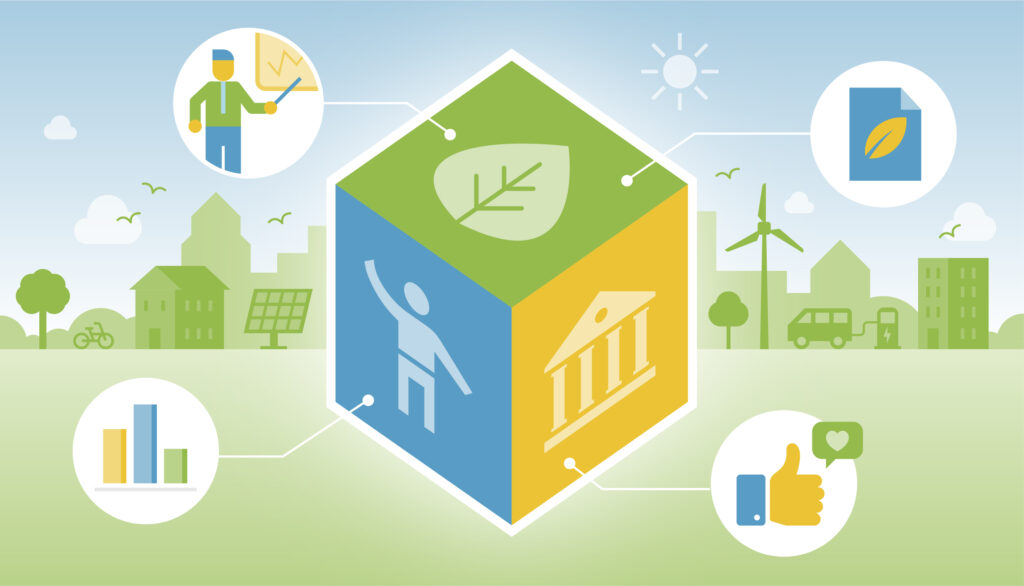Mastering the Art of Sustainability Reporting
Sustainability & ESG, Guides / January 16, 2024
By Paul Gassett, Chief Executive Officer

Sustainability reporting has become an essential aspect of business operations in recent years. Companies are increasingly expected to disclose their environmental, social, and governance (ESG) performance to stakeholders, including investors, customers, and employees. As a result, the design of sustainability reports has become a critical component of a company’s overall sustainability strategy.
In this article, we will explore the various aspects of consulting in the sustainability reporting design process and how it can help companies effectively communicate their sustainability efforts.
RELATED ARTICLE
New to ESG or Sustainability Reporting?
Learn about the 7-Step ESG Reporting Process
Why Is Sustainability Reporting Design Important?
Sustainability reporting is crucial because it is the primary means of communicating a company’s sustainability performance to stakeholders. Publishing an annual sustainability report that complies with your selected standards and/or frameworks is critical to maintaining accountability and allowing for transparency with your stakeholders.
A well-designed sustainability report can effectively showcase a company’s sustainability efforts, build stakeholder trust, and enhance its reputation.
The Role of Sustainability Metrics
Sustainability metrics are a critical component of sustainability reporting design. These metrics provide quantitative data on a company’s sustainability performance, such as energy consumption, greenhouse gas emissions, and waste reduction. They help stakeholders understand a company’s sustainability efforts and track progress over time.
Consultants can assist companies in selecting the most relevant sustainability metrics for their industry and business goals. They can also help companies set targets and develop strategies to improve their performance in these areas.
Sustainability Design Starts with Authentic Storytelling
ESG storytelling is fast becoming one of the most important parts of any organization’s communications toolkit. And being authentic is a key component when telling your ESG story.
Sustainabiity consultants assist companies in communicating their ESG story in a way that is informed by strategy and motivated by a desire to make a positive contribution to society as a whole. For example, sharing the steps you are taking to make a difference is important instead of simply talking about your company’s values or commitments. Sharing concrete actions is more impactful than vague promises. The right sustainability partner will tell your story in a meaningful and impactful way.
Design for Better Communication
The effectiveness of a sustainability report is largely impacted by its design. It should be well-organized, visually appealing, easy to navigate, and present information clearly and concisely.
Sustainability report design consultants are skilled professionals who can provide valuable insights on optimizing design. For example, they can recommend using infographics and data visualization techniques to make complex information more accessible to stakeholders. They can also assist companies in achieving a balance between text, visuals, and white space to ensure that the report is easy to scan, engaging, and informative.
How Can Consulting Help in the Sustainability Reporting Process?
Consulting can play a crucial role in the sustainability reporting design process. Here are some ways consultants can assist companies in creating effective sustainability reports.
Understanding Issues and Frameworks
Key decision-makers in organizations must stay informed on ESG regulations and industry trends. This ensures decisions align with sustainability standards, comply with regulations, and contribute to long-term success and corporate reputation.
Investing in ESG training for team members enhances decision-making effectiveness and promotes a sense of cohesion and synergy. A shared understanding of ESG goals enables effective teamwork and proactive identification of potential risks and opportunities. Sustainability or ESG training helps unify a company’s efforts and increase understanding of why sustainability is important.
Choosing the right ESG reporting framework can be daunting, but with proper training and knowledge, you can confidently evaluate each framework’s suitability based on your organization’s unique goals and priorities. This ensures effective communication of your commitment to sustainability and responsible business practices, meeting expectations of stakeholders and investors.
Identifying Material Issues
To manage and meet stakeholder’s expectations effectively, it is important to conduct materiality assessments. These assessments help you understand the important issues and concerns of stakeholders. They also provide a complete view of the topics that should be a priority in your organization’s operations.
Material issues are those that have a significant impact on a company’s sustainability performance and are of interest to stakeholders. Identifying material issues is crucial in designing sustainability reports because it helps companies focus on the most relevant sustainability metrics and topics. To accurately identify these topics, involving stakeholders in the process is ideal. One way to do this is by conducting a materiality assessment every two to three years to stay current with stakeholders’ needs.
Consultants can help companies identify material issues by engaging with stakeholders and conducting materiality assessments. This process involves interacting with stakeholders to understand their expectations and concerns and align them with the company’s sustainability performance.
The stakeholders involved in this assessment can include investors, company leaders, employees, community members, NGOs, and municipalities. Involving these stakeholders provides different perspectives and insights to aid in decision-making and ensure that the organization meets their expectations.
Use the results of the materiality assessment and other stakeholder feedback to establish your organization’s ESG strategy, set measurable goals, and establish key performance indicators to monitor progress.
Developing a Reporting Strategy
A reporting strategy outlines a company’s sustainability goals, scope, and approach. It is essential to have a clear and well-defined reporting strategy to ensure the report effectively communicates the company’s sustainability efforts.
Consultants can help companies develop a reporting strategy that aligns with their sustainability goals and stakeholder expectations. They can also provide guidance on reporting frameworks, such as the Global Reporting Initiative (GRI) and the Sustainability Accounting Standards Board (SASB), to ensure the report meets industry standards.
It is also critical to understand the regulations required by the European Sustainability Reporting Standards (ESRS) as a managed framework to help companies comply with the European Union’s (EU) Corporate Sustainability Reporting Directive (CSRD).
Expanding on that, Forbes noted in a recent article that:
“More than 50,000 EU-based companies and approximately 10,400 non-EU enterprises will be subject to CSRD compliance, according to a Wall Street Journal article that cites research from financial data firm Refinitiv. Nearly one in three of those non-EU companies (31%) are based in the United States. Whether we like it or not, mandatory ESG reporting will soon become a reality for these companies.”[1]
Data Collection, Benchmarking and Transparency
Collecting and analyzing data is a crucial aspect of sustainability reporting. Companies need accurate and reliable data to report on their sustainability performance effectively.
It’s important to understand a company’s ESG progress in the context of its industry. Simply sharing information about a company’s sustainability efforts is not enough. To demonstrate a true commitment to sustainability, a company should also share its benchmarks. This can be done in a nuanced way, such as by comparing the company’s performance to that of its peers or to industry standards. Providing this context helps all stakeholders understand the company’s progress more fully and accurately.
Transparency is important. If a measurement or benchmark is relevant, focus on it. If it’s a difficult one, like Scope 3 emissions, acknowledge that it’s difficult. Be honest about what you know and what you don’t know. Explain how you plan to gather more information and when you expect to have that information. And then keep everyone informed. Being transparent is just a part of good management.
Consultants can help companies collect and study sustainability data to ensure its accuracy and relevance. They can also assist companies in creating systems to track and report on sustainability metrics consistently.
Design and Layout
The design and layout of a sustainability report are critical in engaging stakeholders and effectively communicating a company’s sustainability efforts.
Experienced design consultants can provide valuable insights on design and layout, ensuring the report is visually appealing and easy to navigate. Consultants possess the expertise to transform complex and dense text, data, and facts into a comprehensive and reader-friendly sustainability report. They do this by carefully selecting design elements that can transform the report into a coherent narrative.
For instance, they may use photography, infographics, tables, and charts to visualize data that would otherwise be difficult to comprehend. They may also make use of infographics and visual aids to present the information clearly and concisely. By doing this, the design consultants can ensure that the sustainability report is informative, engaging, and easy to read.
They can also assist companies in creating a consistent design and layout across all sustainability reports, enhancing brand recognition and credibility.
Review and Assurance
Review and assurance are essential steps in the sustainability reporting process. Companies need to ensure the accuracy and reliability of their sustainability data and report before publishing it.
Consultants can provide independent review and assurance services, giving stakeholders confidence in the report’s accuracy and credibility. They can also assist companies in responding to stakeholder feedback and addressing any gaps or areas for improvement in the report.
Real-World Examples of Consulting in Sustainability Reporting Design
One example of a collaboration on sustainability reporting design is the partnership between OBATA, a leading sustainability reporting design firm, and Renesas Electronics.
- OBATA assisted Renesas in developing a sustainability reporting strategy that aligned with the company’s sustainability goals and stakeholder expectations.
- The result was a comprehensive and visually appealing sustainability report effectively communicating Renesas’ sustainability efforts to stakeholders.
Who Is Responsible for Sustainability Reporting?
The responsibility for sustainability reporting typically falls on a company’s sustainability or ESG team. However, consultants can be crucial in supporting and guiding these teams in the ESG reporting strategy, writing and design process. For companies that do not have an ESG team, or are completely new to ESG, a consultant who provides fractional sustainability services can serve in that role.
Takeaways
Sustainability reporting design is a critical aspect of a company’s sustainability strategy. It is essential to have a well-designed report that effectively communicates a company’s sustainability efforts to stakeholders.
Consulting can play a crucial role in the sustainability reporting design process by providing valuable insights and support in materiality assessments, data collection and analysis, and design optimization. Companies can create effective sustainability reports that enhance their reputation and build trust with stakeholders by working with consultants.
[1] https://www.forbes.com/sites/jimdeloach/2023/09/13/esg-reporting-is-already-required-heres-what-you-need-to-know/?sh=805f79d10742



